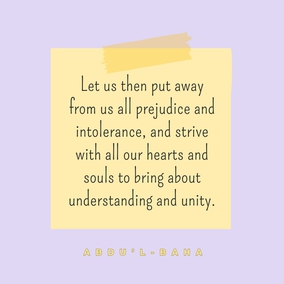The views expressed in our content reflect individual perspectives and do not represent the authoritative views of the Baha'i Faith.
The Baha’i writings contain extensive references to the prophecies found in Judeo-Christian and Islamic scriptures – and directly connect them to the Baha’i concept of progressive revelation.
Shoghi Effendi, the Guardian of the Baha’i Faith, summarized the idea of progressive revelation this way:
The fundamental principle enunciated by Baha’u’llah … is that religious truth is not absolute but relative, that Divine Revelation is a continuous and progressive process, that all the great religions of the world are divine in origin, … and that their missions represent successive stages in the spiritual evolution of human society.
This concept of progressive revelation as “the bedrock of Baha’i belief” permeates every aspect of the Baha’i Faith. That generative idea creates entirely new perspectives on how religion, civilization, and history relate to each other – and helps us better understand and interpret the prophecies of the past.
Concerning prophecies, the concept of progressive revelation provides a foundation for a hermeneutic perspective on how to validate and interpret foreknowledge of future events revealed in religious scriptures. One of the conclusions that can be drawn from the concept of progressive revelation is that old scriptures need to be understood and given specific context in light of the new knowledge revealed by the latest and fuller revelation of God.
According to the Baha’i teachings, great world religions have a common thread underlying their origin and purpose – they are all divine in origin and together constitute one perennial religion:
The foundations of the divine religions are one. If we investigate these foundations, we discover much ground for agreement … The essentials of the divine religion are one reality, indivisible and not multiple.
Christ established his cause on the foundation of the Mosaic dispensation. Muhammad recognized the signs and prophecies of Jesus as divinely ordained. Jesus himself, declared: “I go away and come again unto you.” Hence, in the Baha’i dispensation:
Every proof and prophecy, every manner of evidence, whether based on reason or on the text of the scriptures and traditions, are to be regarded as centered in the persons of Baha’u’llah and the Bab. In them is to be found their complete fulfillment. – Shoghi Effendi, The World Order of Baha’u’llah.
The idea that a new revelation has the authority to subsume the previous revelations derives from humanity’s continual process of intellectual development and alteration of old views in terms of new experiences. Humanity invariably moves from one stage of understanding to another. If we define the new in terms of the old, we create an intellectual fixation and stop human progress. If we define the new with disregard for the past, we create an intellectual vacuum.
The solution: neither neglect of the past nor an obsessive return to it. Prophecies need to be reinterpreted within the context of the new revelation to reflect constructive accommodations to the dynamics of a new consciousness and an emerging spiritual paradigm. Without such modifications, interpretations of prophecies tend to crystallize into dysfunctional dogmas. The concept of progressive interpretations of prophecies calls for a process-oriented theology and progressive fulfillment of God’s will. It carries with it a union of revelation and civilization that fulfills the extraordinary promise of God in the context of humanity’s social evolution and the course of history.
Science also follows the same logic. Science uses new conceptual configurations to determine the validity or the falsity of old concepts. For instance, the Newtonian model established new laws of motion that radically differed from traditional conceptions. The Newtonian model became a new paradigm and a criterion with which to judge the probable truth of past ideas. The Newtonian model, however, derived its premises from the works of previous models and cosmologies, and the cumulative tradition of knowledge from Aristotle and his predecessors to Kepler and Galileo. Likewise, groundbreaking findings of modern physics altered mechanistic assumptions of the Newtonian model and replaced it with Einstein’s Relativity and the Quantum Revolution. In brief, science moves forward by giving the latest scientific model broader explanatory power to evaluate the merits and plausibility of previous assumptions.
From a Baha’i point of view, any discussion of prophecies must be accompanied by the body of affirmations about the new revelation and the world view from which it originates. These affirmations are delineated in the entirety of written texts of Baha’u’llah. In these texts, Baha’u’llah reveals the will of God for today while discussing the foundation of the Baha’i paradigm, namely, the concept of progressive revelation as the overriding method of God’s intervention in human history.
The recognition of this foundation, Baha’u’llah asserts, provides the master key that allows us to unlock the true meaning of the scriptures and their prophecies.
The Baha’i view holds that everything grows, changes and progresses, including nature, divine revelation and our perception of reality. This dynamic foundation automatically rejects any fundamentalist view that claims to hold the final and ultimate revelation of God. For example, some Christians believe that Jesus Christ is the pivot around which revolves the past, present, and future. Baha’i interpretations, however, consider this as a reflection of a static theology under which history stands still. The same notion is invoked in the Islamic conjecture concerning the station of Muhammad as the Seal of the Prophets, and his religion as the last and ultimate revelation from God. Baha’u’llah wrote that in every dispensation:
… people have occupied themselves with such foolish absurdities … that all Revelation is ended, that the portals of Divine mercy are closed, that from the daysprings of eternal holiness no Sun shall rise again, that the Ocean of everlasting bounty is forever stilled, and that out of the Tabernacle of ancient glory the Messengers of God have ceased to be made manifest.
Prophecies offer us divinely inspired declarations of things to come, veiled in metaphorical language. But some are also heavily mired in cultural traditions and conventions. The Baha’i perspective, however, expands the cultural milieu of prophecies to a global level. In doing so, it liberates the prophecy from the prejudices and limited understandings of its original audience. It embraces all religious traditions, extends the region of space-time, and links the past and the future to unravel the mysterious elements of prophecies and put the pieces of the puzzle into a coherent whole.
Furthermore, it focuses on the persons of the prophets who inaugurated new dispensations in an orderly, continuous, and progressive process. The Baha’i teachings emphasize that every prophecy centers on the person of the prophet or messenger of God. The ultimate purpose of prophecy is fulfilled in recognition of the successive stages in the spiritual evolution of human society. Baha’u’llah warns the clergy and ecclesiastics not to pass by this profound truth for the sake of literal interpretations and technical debates over the fulfillment of prophecies.
The recognition of this underlying foundation can help us disentangle the true meaning of prophecies. To use an analogy, one might say, interpretation of prophecies is analogous to the artistic appreciation of a modernist painting. Let us assume that we want to explain a cubist painting to a first-time observer. We are faced with two choices: either to redraw the painting in order to make it pertinent to the observer’s preconceptions and previously constructed sense of reality, or to help the observer to develop a clarity of vision so he may be able to see beyond the literal, in order to behold the beauty of the painting subjectively.
Likewise, religious prophecies can also be interpreted in two ways: they may be reinterpreted according to the traditional frame of reference by haggling over piecemeal methods, or they may be reinterpreted by elaborating on the meanings of their metaphors, deconstructing the past, and reconstructing it into an evolving framework of progressive revelation and the essential oneness of all revealed religion.
You May Also Like
Comments

















revelation and most other things!